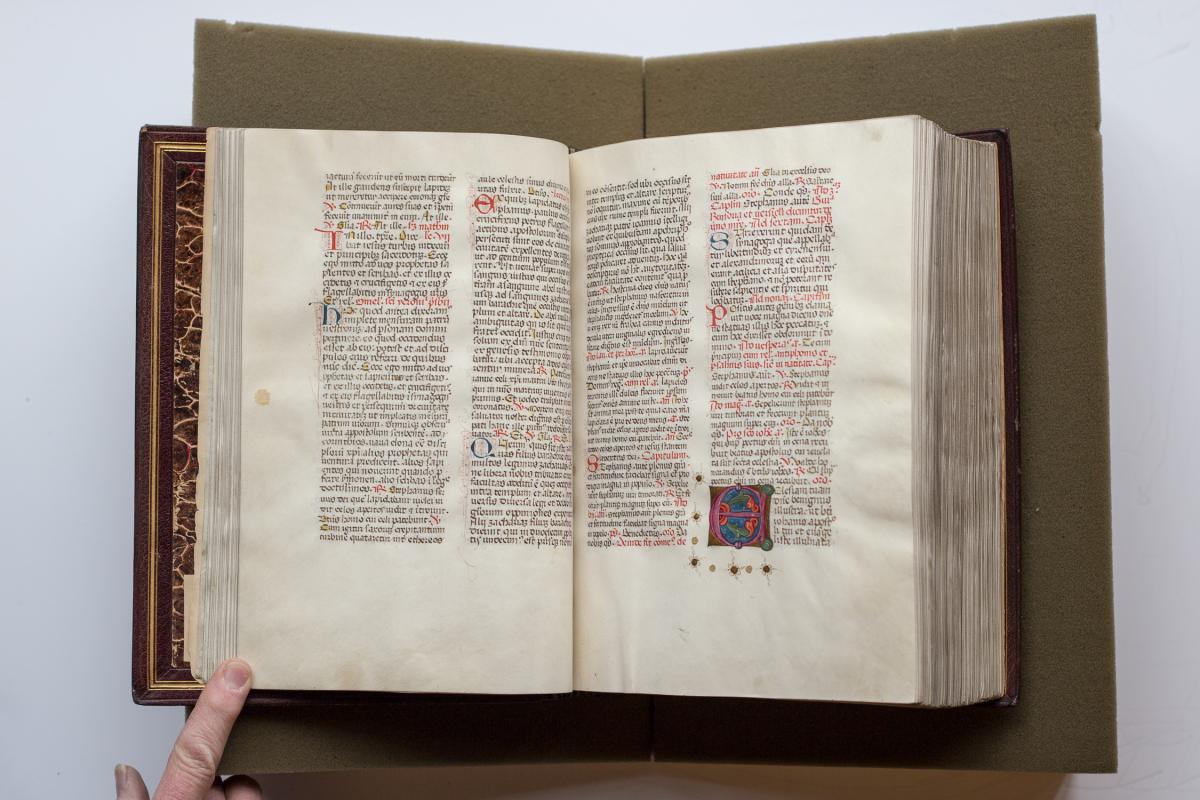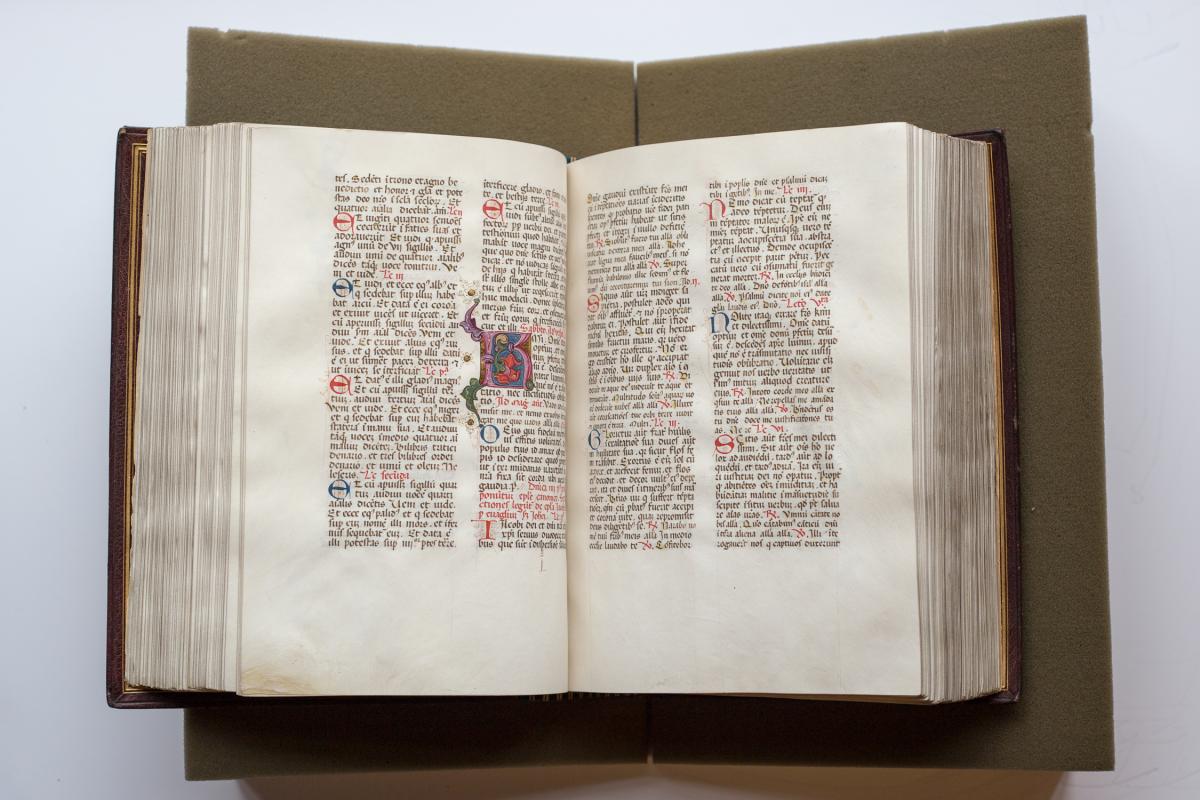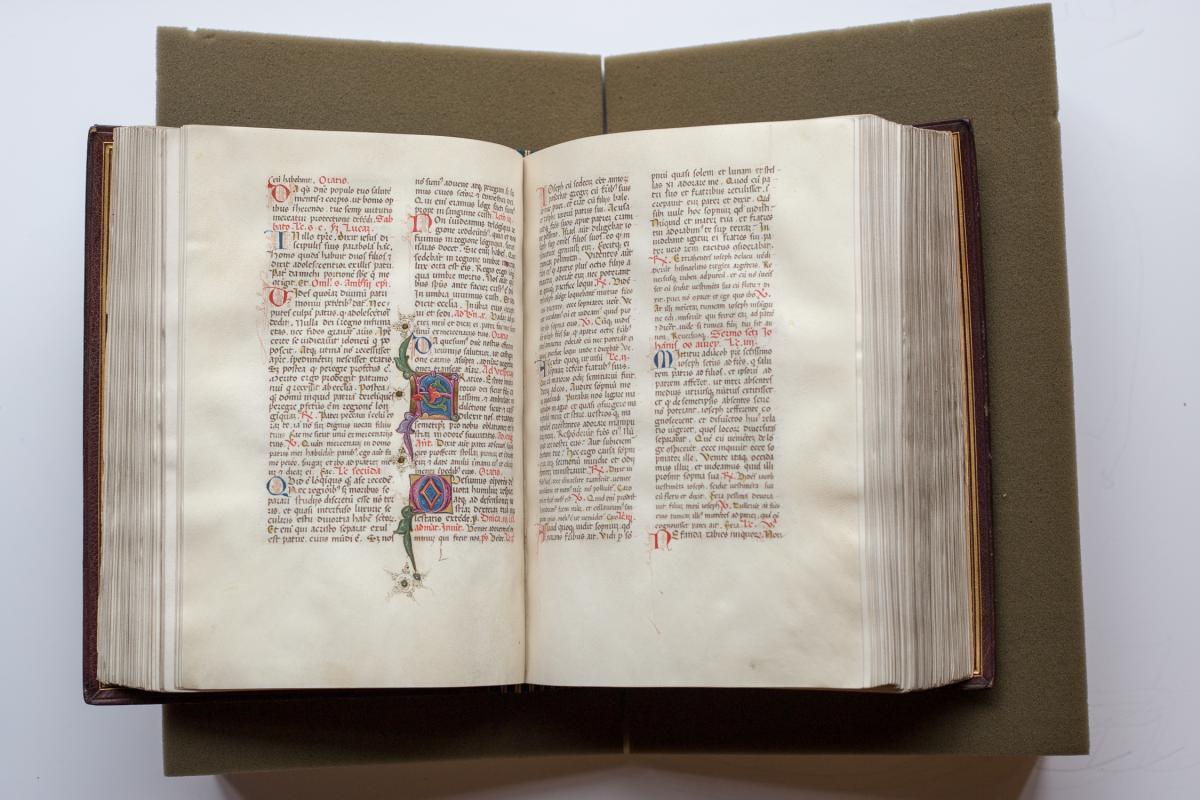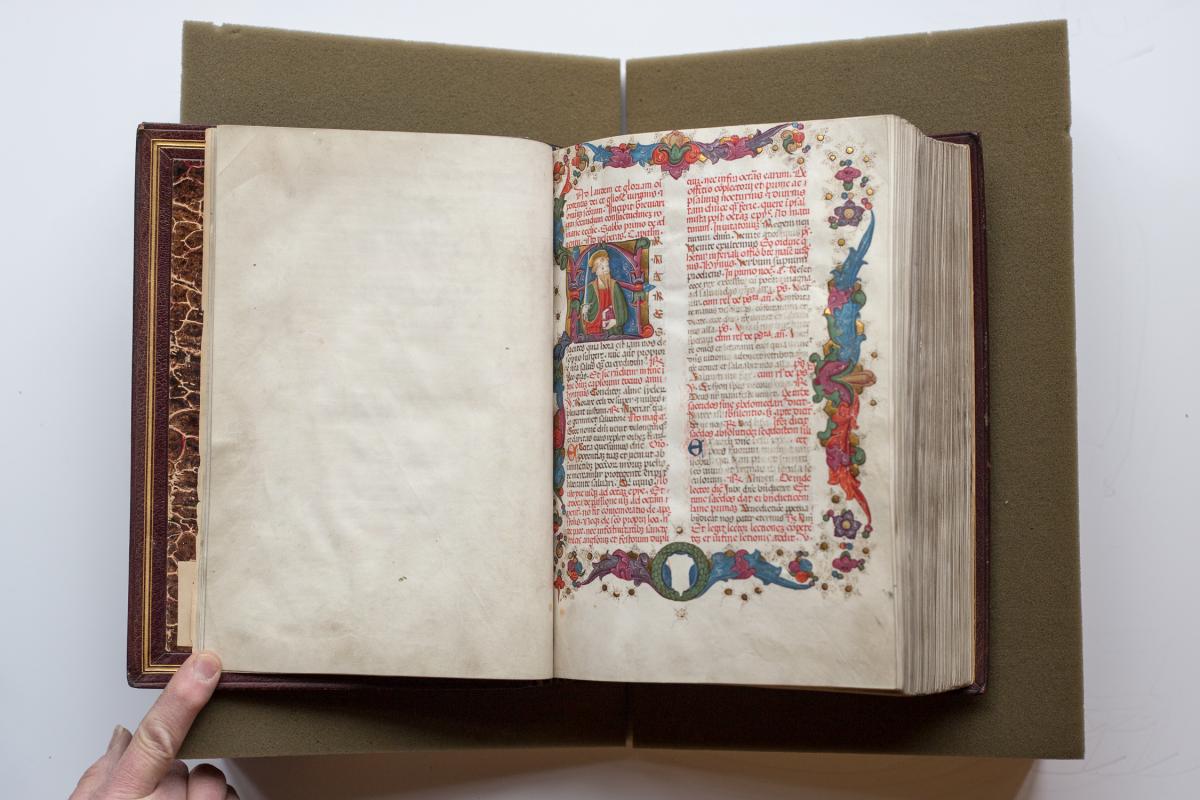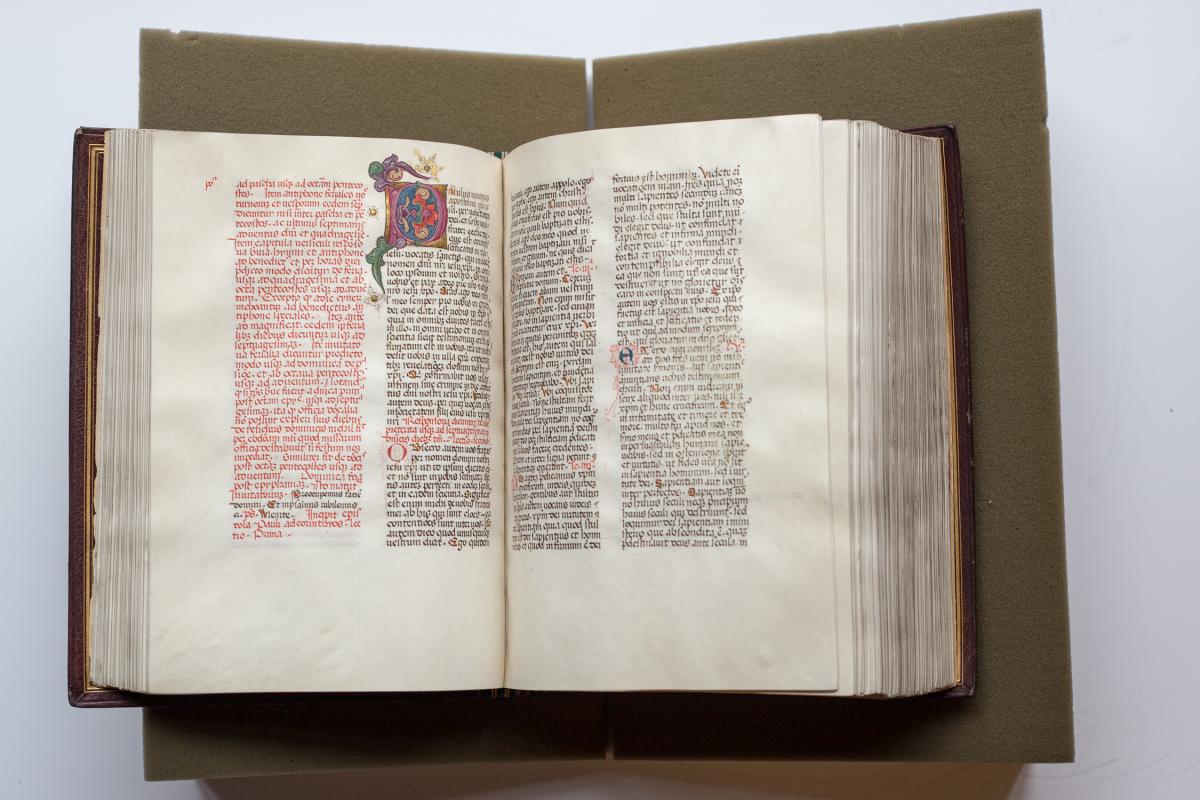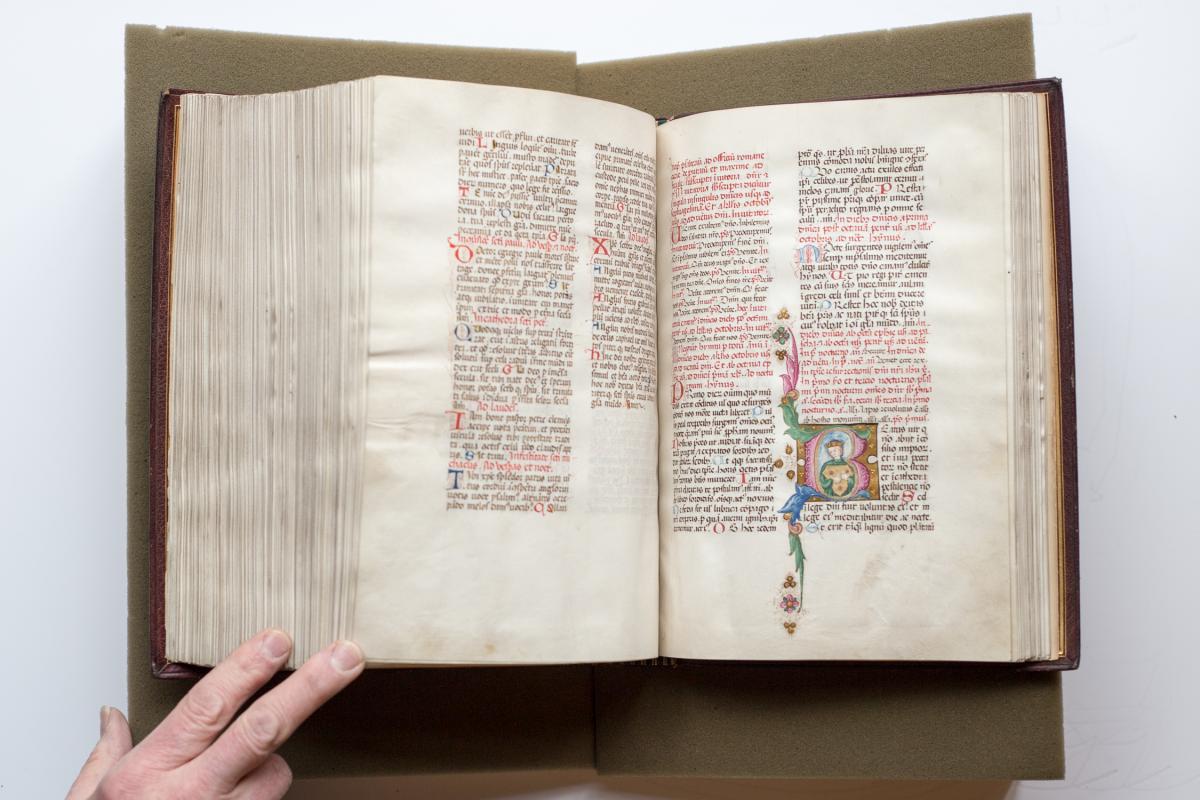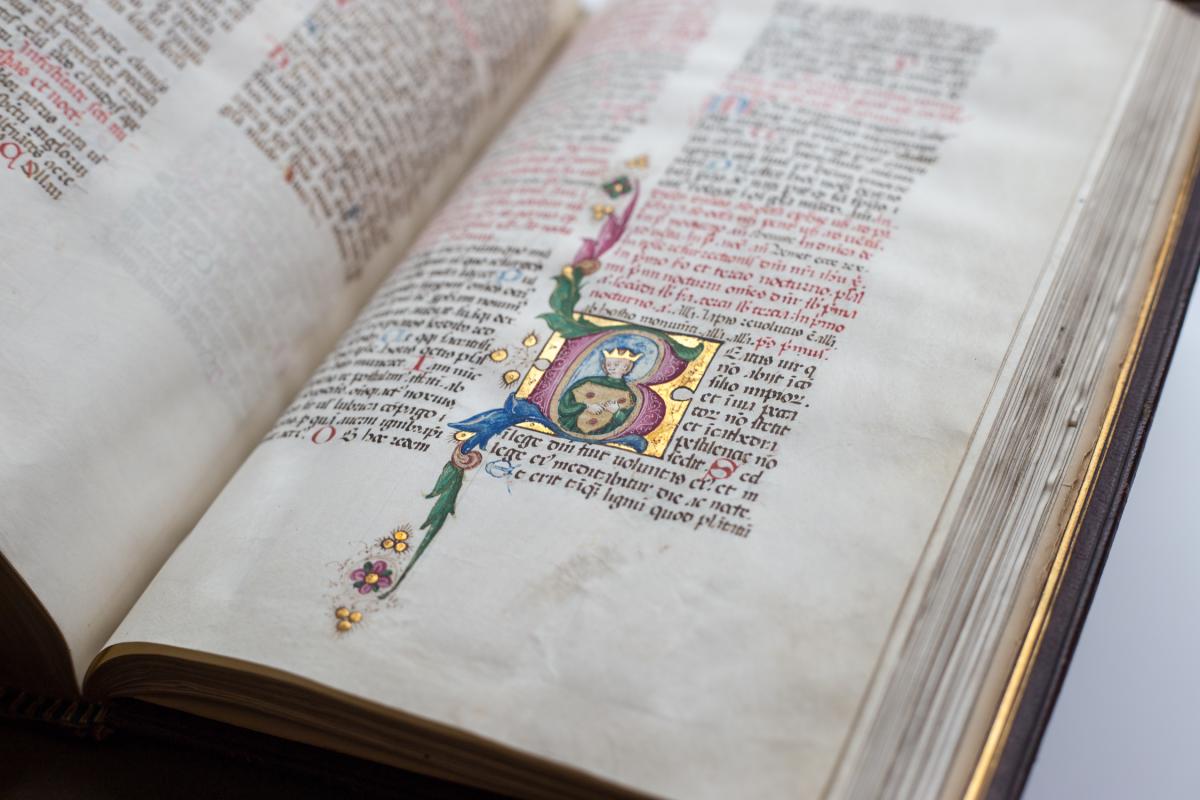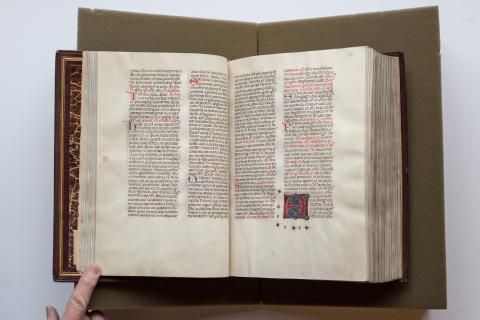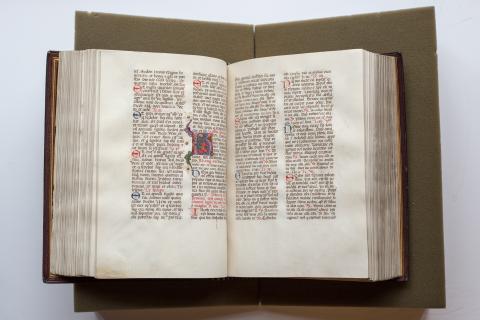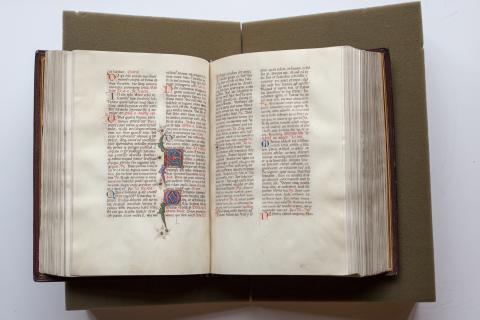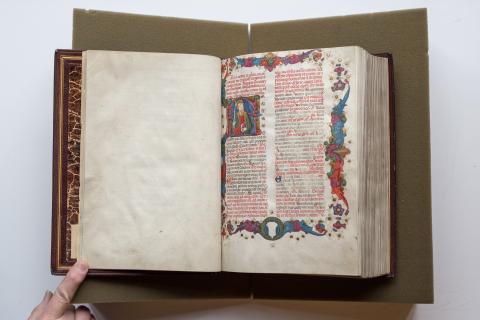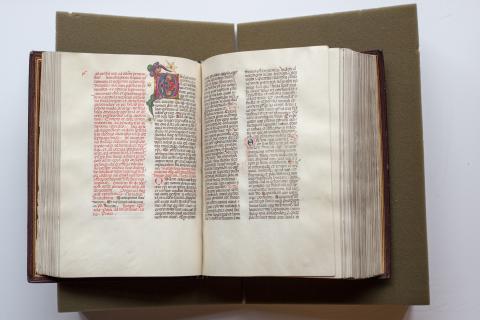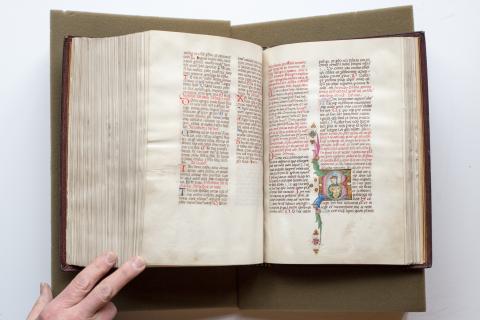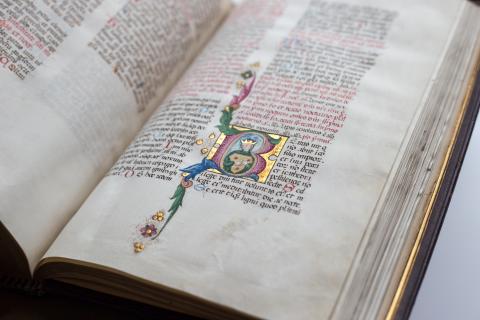Breviary, Use of Rome
Breviary, Use of Rome
Italian, ca. 1500
height 27 cm
width 19.5 cm Manuscripts
422 leaves. Rounded Italian Gothic script. 39 lines in 2 cols. Gatherings mostly of 10. Text in Latin: Roman Breviary with Calendar. 3 historiated initials, many decorated initials and borders. Binding: crushed red morocco, H. Southeran and Co., London, modern. Full title: Breviarum Romanum: cum calendario. Full Multnomah County Library Catalog.
Provenance and Prior Publication:
Earl of Hopetoun (ex libris); H. Southeran and Co., London (cat., 1891); John Wilson (ex libris).; Publications: Parshall 17, p. 40 and Seymour De Ricci, with the assistance of W. J. Wilson.
Multnomah County Library, John Wilson Special Collections: W091 B846
Parshall, Peter. Illuminated Manuscripts from Portland Area Collections. Portland, OR: Portland Art Museum, 1978, p. 40 - Quoted with permission
The initial types and colorful border designs of this Breviary are generally characteristic of Italian work from the latter half of the fifteenth and early sixteenth centuries. Its kinship with the style of the Florentine Hours (Cat. 16) in contrast to French and Flemish illumination is readily apparent. Italian borders tended to be of two general types - the voluminous foliage patterns with discs of gold leaf such as in the Breviary, and delicate panels of interlace preferred for secular as well as some religious texts. The text is written in a clean and regular Italian hand, luxuriously disposed in two columns on sheets of uniform white vellum. The historiated initials portray figures of St. Paul (9r), St. John the Evangelist (337r), and King David (374 r). These are done in a doughy, painterly technique with drapery cast in mannered linear patterns. The formulaic style is difficult to assign a precise localization and date, though it seems more characteristic of work from northern Italian centers of illumination. Frequent references in the text to St. Francis and the Franciscan Brotherhood suggest the Breviary may have been intended for use by members of that order.
Wilma Fitzgerald, PhD, SP - Quoted with permission from an unpublished study
Breviarium Romanum cum kalendario. Franciscan use. Saec. XV. FF. i (paper} + ii + 420 + 1 (paper) (modern foliation), 270 x 190 (180 x 140) mm., two columns, 39 lines. Wanting first leaf of Proprium sanctorum before f. 178. FF. 175, 176, 177 ruled but blank, f. 330v and 332r-v blank. 47 large initials in bright colors and gold. Miniature of King David at beginning of Psalter f. 371. Book plate of John Wilson inside front cover. Purchased from H. Southeran & Co. # 417. Cover is old stamped calf circa saec. XVI. Earl of Hopetoun bookplate on f. i verso. Motto: Tria juncta in uno at spes non fracta. Calendar added. Note: April 29 S. Petri m. de ordine predicatorum; May 3 Alexandri pape, 26 translatio beati Francisci; June 13 Sancti Antonii conf. ordinis minoum; July 26 Sancte Anne; Aug. 7 Sancte Redegunda virginis [added], 20 Sancti Lodouici ordinis minorum epi.; October 2 Translatio sancte Clare, Oct. 4 Nativitas b. Francisci fundatoris ordis minorum.
Note on f. 316v feast of St. Frances of Assisi with initial but no miniature. Hymns: Proles de celo prodiit, In celesti collegio nouus. Lesson 1: De stigmatibus. Nouus hoc Franciscus nouo et stupendo miracula claruit cum singulari privilegio.
Nicole Emrick, Medieval Portland Capstone Student, Summer 2005
This Breviary from the 15th century contains a patterned paper or marbled inlay with a stamp of John Wilson's ownership and the location of its rebinding. The bookplate also indicates that the Earl of Hopetown once owned the book. It contains 422 thin relatively uniform white vellum. While the script of this leaf is almost certainly Italian workmanship, the initial letters and filigree decoration might easily be French influence, and the use of green ink in the borders, as well as blue, suggests English manufacture. Although the formulaic style makes it difficult to assign a precise date and location most of the characteristics such as the medium, colors, and style used suggest it is of Italian workmanship. The rotunda book hand used in this work represents the general excellence maintained by Italian scribes at the time when printing was being introduced into their country. The text is written in well-executed rotunda (round) gothic script in two columns with approximately 40 lines per column and gathered in segments of 10 lines which are distinguished by the change of color from a rich brown to red which dates as far back as the fifth century and flourished until the fifteenth. Sometimes, as in this leaf, they had interlinear neumes in red to assist the deacon or sub-deacon in chanting parts of this section of the church service while he was standing on the second step in front of the altar.
Perhaps it was written for the use of its members of the Franciscan order because of the frequent references to St. Francis and the Franciscan Brotherhood. This implies that the time period of this work was prior to the sixteenth century otherwise the printing press would have been employed if multiple copies of this book were to have been produced for the members of the Franciscan Brotherhood.
Some margins contain additions to the text in stylus; the words which were inserted in the margin are not corrections but were directions to the scribe and added as guides to the content of the page. The lines drawn to create the symmetry of the piece were drawn with a stylus usually composed of two parts lead and one part tin. The thousands of small decorated letters that fill the pages as well as the dorsal decorations on larger initials represent the same high standard of craftsmanship. The colorful border designs and bold Lombardic initials suggest it was created in the later part of the fifteenth century or early sixteenth century. The colors used in the 47 large illuminated letters are only red and blue suggesting once again its Italian origin. Three historiated initials are the most significant illumination. The first initial located on page eight is that of St. Paul. The other two figures are that of St. John the Evangelist located on page 333 and that of King David located on page 371. St. Paul is depicted as a thin-faced elderly man with a long, pointed beard and a receding hairline. He is not only distinguished by his appearance but by the sword and the book, most likely a Bible. St. John the Evangelist is also known as St. John the Apostle and is characterized by holding a wreath. The miniature found in the back of the manuscript is that of King David because instead of a halo he has a crown. Early Christian art usually represents King David for his success recognized by all surrounding nations. He is not only named in liturgy for his killing in war and his reign as ruler but also a prophet and author of poems and hymns such as the Book of Psalms.
The manuscript type called a Breviary is one of six official books used by the Roman Catholic Church in its liturgy. The Pontifical, the Missal, the Ritual, the Martyrology, and the Ceremonial of the Bishops are the other five official books. The Breviary was assembled into one volume from books used from the 11th century for the Divine Office and includes the Psalter, the Antiphonal, the Lectionary, the Collectar, the Martyrology, books of the Bible, prayers, hymns, and selected writings of the Fathers. It is a book of prayer for the clergy that they recite daily, giving them directions for all of the various services of the Divine Hours throughout the year and thus Breviaries were seldom owned by laymen. A Breviary is divided into four parts for each of the seasons: fall, winter, spring, and summer and contains the Psalter with the versicles, responses, collects, and lections for Sundays, weekdays, and saints' days, although other texts could be included. A Breviary, therefore, was lengthy and usually bulky in format. The first portion of this Breviary in the Wilson Room contains a Calendar that is written mostly in red, differentiating it from the remainder of the manuscript. This portion of the book sets apart the seasons, months, as well as days and their celebrations.
Suggestions for Further Reading:
- Bischoff, Bernard. Latin Palaeography. Cambridge: Cambridge University Press, 1990.
- Brown, Michelle P. Understanding Illuminated Manuscripts: A Guide to Technical Terms. Los Angeles: Getty Publications, 1994.
- Diehl, Edith. Bookbinding: Its Background and Technique. New York: Rinehart & Co., 1946. 2
- Drogin, Marc. Medieval Calligraphy. New York: Courier Dover Publications, 1989. v.2
- James J. John, "Latin Paleography," Medieval Studies: An Introduction. 2nd ed. Syracuse, N.Y.: Syracuse University Press, 1992.
- Needham, Paul. Twelve Centuries of Bookbindings 400-1600. New York: Pierpont Morgan Library/London: Oxford University Press, 1979.
- Parshall, Peter W. Illuminated Manuscripts: From Portland Area Collections. Portland: Portland Art Museum, 1978.
- Trinity Communications. Introduction to the Roman Breviary. Trinity communications: Manassas, VA 1990.
- Ancestry.com: John Wilson and the John Wilson Room August 17, 2005. http://www.ancestry.com/library/view/ancmag/4129.asp
- Latin Breviary. August 10, 2005. www.breviry.net
- Introduction to 19th-century bookbinding. August 17, 2005. http://www.redwoodlibrary.org/onlineexhibition/moreintro.htm

